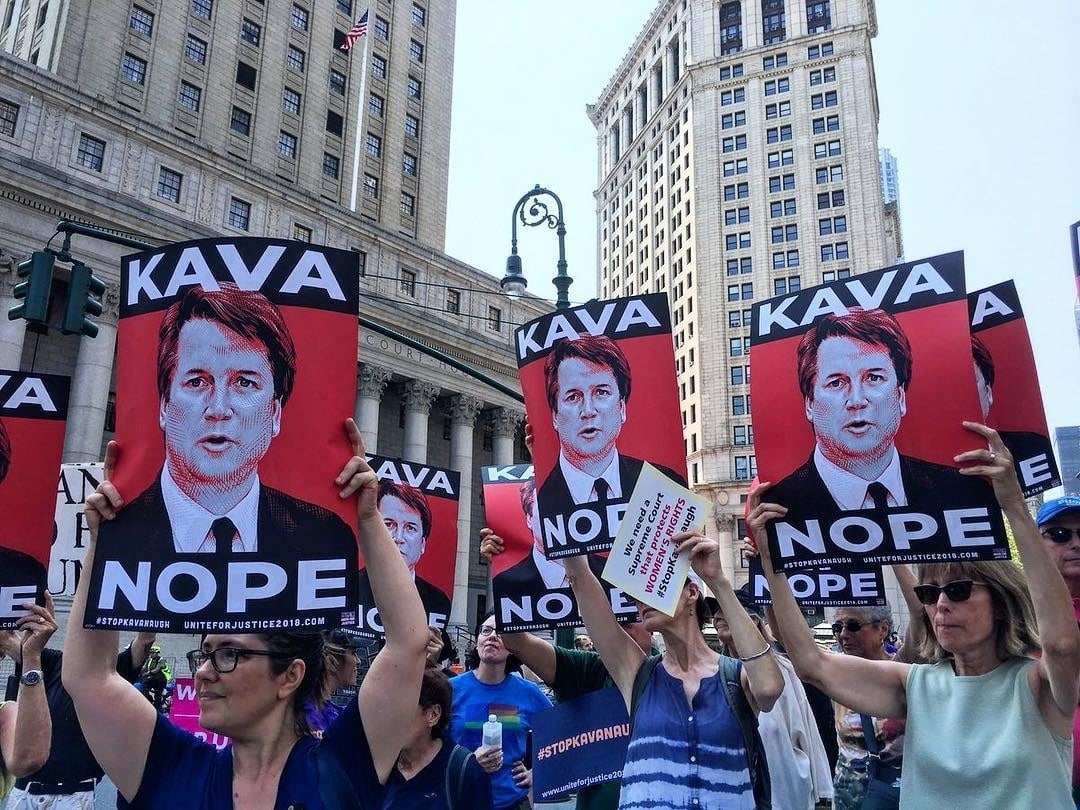
The contentious confirmation hearings for judge Brett Kavanaugh drew to apparent close in Washington, DC, this afternoon, with the Senate Judiciary Committee voting to advance president Donald Trump’s Supreme Court nominee to the full Senate, despite a last minute request for an FBI investigation from Jeff Flake. Both inside and outside of senate chambers, protesters have been outspoken in their disapproval of Kavanaugh, widely seen as a threat to women’s reproductive rights, and now accused of sexual misconduct by three different women.
Omnipresent among the signs and posters brandished by demonstrators across the country in recent weeks is a stark image of the nominee, rendered in red, gray, black, and white, a slightly befuddled expression on his face. The text reads “KAVA NOPE” on two lines, split above and below the judge’s face.
The graphic is the work of DC-based illustrator and “vector artist” Tracie Ching, who created the image for the group Unite for Justice and its coordinated day of action opposing Kavanaugh’s nomination on August 26. On the bottom of the image, she included the #StopKavanaugh hashtag and a link to the Unite for Justice website.
As a commercial illustrator, Ching’s clients have included Adobe, Disney, TIME, Google, and Marvel. She has also launched her own mentorship and grant program, christened She Creates, for which she will meet with and advise a female artist, designer, or illustrator, over the course of one year, culminating in a $2,000 grant upon completion of the program.
Activist demonstrate against US Supreme Court nominee Brett Kavanaugh in front of the court in Washington, DC, on September 28, 2018. Many hold Tracie Ching’s Kavanope poster. Photo by Eric Baradat/AFP/Getty Images)
The graphic style of her “KAVANOPE” poster clearly evokes Shepard Fairey’s instantly recognizable Hope poster for former President Barack Obama’s 2008 campaign, with the word “NOPE” replacing “HOPE” in Ching’s new image.
In the decade since its origin, Fairey’s iconic image has been an easy starting point for parodies of all kinds. These have included a variety of widely circulated images of president Donald Trump, who has been accused of sexual harassment himself, replacing “HOPE” with “GROPE.”
The October 2016 cover of the British satire magazine Private Eye.
While many artists have created works inspired by Fairey’s striking image, Ching has made the design her own, incorporating intricate crosshatching in her portrait. The intersecting lines are a staple of her expertly drafted work, but here take on a somewhat sinister quality.
(The same style is in evidence on an April 13th cover by Ching for Newsweek, for a story about Russian leader Vladimir Putin’s effect on world politics. An accompanying video, embedded below, gives a sense of her process.)
Whereas Fairey’s Hope image is draped in red, white, and blue, suggesting the American flag, Ching’s KAVANOPE has an all-red background, suggesting the colors of the Republican party and also giving it a sinister appearance, when combined with the stark black-and-white text blocks.
Tracie Ching, Kavanope (2018). Image courtesy of the artist.
See more photos of demonstrators with the KAVANOPE poster on the streets below.
US Senator Kamala Harris, US Senator Mazie Hirono, and US Senator Richard Blumenthal, Democrat from Connecticut, speak as demonstrators protest against Judge Brett Kavanaugh’s nomination outside the US Supreme Court in Washington, DC, September 28, 2018. Tracie Ching’s Kavanope poster is prominently displayed against the podium. Photo by Saul Loeb/AFP/Getty Images.
A demonstrator with Tracie Ching’s Kavanope poster at the “Unite for Justice” rally protesting the Supreme Court nomination of Brett Kavanaugh, in Los Angeles on August 26. 2018. Photo by Mark Ralston/AFP/Getty.
Demonstrators protesting against Judge Brett Kavanaugh’s nomination as an Associate Justice on the Supreme Court hold a rally outside the US Supreme Court in Washington, DC, September 28, 2018. Many hold Tracie Ching’s Kavanope poster. Photo by Saul Loeb/AFP/Getty Images.
A woman protests outside of Democratic Senator Chuck Schumer’s office on September 27, 2018 in New York. Tracie Ching’s Kavanope poster appears in the background. Photo by Spencer Platt/Getty Images.
Demonstrators with Tracie Ching’s Kavanope poster protest against the appointment of Supreme Court nominee Brett Kavanaugh on the streets outside on Capitol Hill in Washington DC, on September 27, 2018. Photo by Jose Luis Magana/AFP/Getty Images.
Signs protesting against Supreme Court Nominee Brett Kavanaugh, including Tracie Ching’s Kavanope poster, are pictured near the US Supreme Court on September 27, 2018 in Washington, DC. Photo by Zach Gibson/Getty Images.
Tracie Ching’s Kavanope poster at the “Unite for Justice” rally protesting the Supreme Court nomination of Brett Kavanaugh, in Los Angeles on August 26. 2018. Photo by Mark Ralston/AFP/Getty Imags.
Protesters hold up signs, including Tracie Ching’s Kavanope poster, during a rally near Capitol Hill against the confirmation hearing for Judge Brett Kavanaugh to be an Associate Justice on the US Supreme Court in Washington, DC, on September 4, 2018. Photo by Andrew Caballero-Reynolds/AFP/Getty Images.